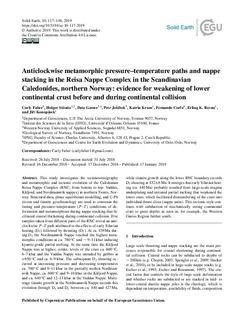| dc.contributor.author | Faber, Carly | |
| dc.contributor.author | Stunitz, Holger | |
| dc.contributor.author | Gasser, Deta | |
| dc.contributor.author | Jeřábek, Petr | |
| dc.contributor.author | Kraus, Katrin | |
| dc.contributor.author | Corfu, Fernando | |
| dc.contributor.author | Ravna, Erling Krogh | |
| dc.contributor.author | Konopásek, Jiří | |
| dc.coverage.spatial | Norway | nb_NO |
| dc.date.accessioned | 2019-05-31T12:12:00Z | |
| dc.date.available | 2019-05-31T12:12:00Z | |
| dc.date.created | 2019-01-20T19:40:29Z | |
| dc.date.issued | 2019 | |
| dc.identifier.citation | Faber, C., Stünitz, H., Gasser, D., Jeřábek, P., Kraus, K., Corfu, F., . . . Konopásek, J. (2019). Anticlockwise metamorphic pressure–temperature paths and nappe stacking in the Reisa Nappe Complex in the Scandinavian Caledonides, northern Norway: Evidence for weakening of lower continental crust before and during continental collision. Solid Earth, 10(1), 117-148 | nb_NO |
| dc.identifier.issn | 1869-9510 | |
| dc.identifier.uri | http://hdl.handle.net/11250/2599549 | |
| dc.description.abstract | This study investigates the tectonostratigraphy and metamorphic and tectonic evolution of the Caledonian Reisa Nappe Complex (RNC; from bottom to top: Vaddas, Kåfjord, and Nordmannvik nappes) in northern Troms, Norway. Structural data, phase equilibrium modelling, and U-Pb zircon and titanite geochronology are used to constrain the timing and pressure–temperature (P–T) conditions of deformation and metamorphism during nappe stacking that facilitated crustal thickening during continental collision. Five samples taken from different parts of the RNC reveal an anticlockwise P–T path attributed to the effects of early Silurian heating (D1) followed by thrusting (D2). At ca. 439 Ma during D1 the Nordmannvik Nappe reached the highest metamorphic conditions at ca. 780 ∘C and ∼9–11 kbar inducing kyanite-grade partial melting. At the same time the Kåfjord Nappe was at higher, colder, levels of the crust ca. 600 ∘C, 6–7 kbar and the Vaddas Nappe was intruded by gabbro at > 650 ∘C and ca. 6–9 kbar. The subsequent D2 shearing occurred at increasing pressure and decreasing temperatures ca. 700 ∘C and 9–11 kbar in the partially molten Nordmannvik Nappe, ca. 600 ∘C and 9–10 kbar in the Kåfjord Nappe, and ca. 640 ∘C and 12–13 kbar in the Vaddas Nappe. Multistage titanite growth in the Nordmannvik Nappe records this evolution through D1 and D2 between ca. 440 and 427 Ma, while titanite growth along the lower RNC boundary records D2 shearing at 432±6 Ma. It emerges that early Silurian heating (ca. 440 Ma) probably resulted from large-scale magma underplating and initiated partial melting that weakened the lower crust, which facilitated dismembering of the crust into individual thrust slices (nappe units). This tectonic style contrasts with subduction of mechanically strong continental crust to great depths as seen in, for example, the Western Gneiss Region further south. | nb_NO |
| dc.language.iso | eng | nb_NO |
| dc.publisher | Copernicus GmbH | nb_NO |
| dc.rights | Navngivelse 4.0 Internasjonal | * |
| dc.rights.uri | http://creativecommons.org/licenses/by/4.0/deed.no | * |
| dc.title | Anticlockwise metamorphic pressure–temperature paths and nappe stacking in the Reisa Nappe Complex in the Scandinavian Caledonides, northern Norway: evidence for weakening of lower continental crust before and during continental collision | nb_NO |
| dc.type | Journal article | nb_NO |
| dc.type | Peer reviewed | nb_NO |
| dc.description.version | publishedVersion | nb_NO |
| dc.rights.holder | © Author(s) 2019. | nb_NO |
| dc.subject.nsi | VDP::Matematikk og Naturvitenskap: 400::Geofag: 450 | nb_NO |
| dc.source.pagenumber | 117-148 | nb_NO |
| dc.source.volume | 10 | nb_NO |
| dc.source.journal | Solid Earth (SE) | nb_NO |
| dc.source.issue | 1 | nb_NO |
| dc.identifier.doi | 10.5194/se-10-117-2019 | |
| dc.identifier.cristin | 1661460 | |
| dc.relation.project | Norges forskningsråd: 223272 | nb_NO |
| cristin.unitcode | 203,12,7,0 | |
| cristin.unitname | Institutt for miljø- og naturvitskap | |
| cristin.ispublished | true | |
| cristin.fulltext | original | |
| cristin.qualitycode | 1 | |

